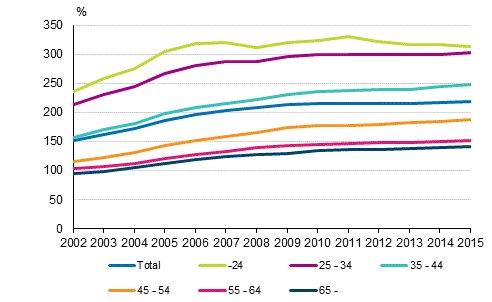Published: 25 January 2017
Debts of household-dwelling units with housing loans are more than double their annual income
The housing loans of household-dwelling units with housing loans amounted, on average, to 219 per cent of their disposable annual income in 2015. The indebtedness was the higher the younger the reference person of the household-dwelling unit was. Among the youngest, the debts were more than triple but even among retirement-aged household-dwelling units with housing loans, the debt was nearly 1.5 times their annual income. The average size of housing loan per household-dwelling unit with a housing loan was EUR 95,740, which was 1.7 per cent more than in 2014.
Rates of indebtedness of indebted household-dwelling units by age of the reference person in 2002 to 2015, %

Two-supporter families with children had most often a housing loan, of whom 71 per cent had housing loans. Of single-supporter families, 38 per cent and of childless household-dwelling units with two adults, 30 per cent had housing loans. Fewer than one in five of one person household-dwelling units had housing loans but the indebtedness of childless household-dwelling units varied considerably by age. Two-supporter families with children had, on average, EUR 128,210 in housing loans and single-supporter families EUR 87,110. Childless household-dwelling units with two adults had, on average, EUR 82,340 in housing loans and one person household-dwelling units EUR 65,190.
There were 1.4 million indebted household-dwelling units, which is 53 per cent of all household-dwelling units in 2015. Household dwelling units' total debts amounted to EUR 114.8 billion. Seventy-three per cent of debts, or EUR 83.9 billion, were housing loans. Household-dwelling units' other debts taken out for consumption or purchases and study loans amounted to EUR 23.9 billion and debts taken out for business purposes to EUR 7.0 billion. From the previous year, debts grew by 2.7 per cent in real terms. Housing loans grew by two, other debts by four and business debts by five per cent.
In one-fifth of indebted household-dwelling units, that is, 270,050 household-dwelling units, debts were at least three times as high as their disposable annual income in 2015. They held one-half of all household-dwelling units' debts. For 65,830 household-dwelling units debts were five times as high as their disposable annual income. Their share of indebted households was five per cent and of the debts of the household-dwelling units 17 per cent. In 2002, for eight per cent of indebted households debts were three times as high as their annual income.
Typically, two-supporter families with children where the reference person was aged under 45 had a lot of debt compared to their income. This was also common among childless household-dwelling units with one or two adults and single-supporter families of the same age.
Household-dwelling units paid EUR 1.8 billion in interests in 2015. Average interest expenses per indebted household-dwelling unit were EUR 1,320. Household-dwelling units paid in real terms one-third less in interest expenses than in 2002 even though their debts had doubled over the same period.
Source: Indebtedness 2015. Statistics Finland
Inquiries: Timo Matala 029 551 3422
Director in charge: Jari Tarkoma
Publication in pdf-format (166.6 kB)
- Tables
-
Tables in databases
Pick the data you need into tables, view the data as graphs, or download the data for your use.
Updated 25.1.2017
Official Statistics of Finland (OSF):
Indebtedness [e-publication].
ISSN=2489-3285. 2015. Helsinki: Statistics Finland [referred: 12.12.2025].
Access method: http://stat.fi/til/velk/2015/velk_2015_2017-01-25_tie_002_en.html

